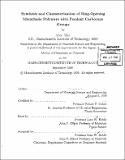Synthesis and characterization of ring-opening metathesis polymers with pendant carborane groups
Author(s)
Man, Alice (Alice Mei-Ling), 1972-
DownloadFull printable version (9.875Mb)
Other Contributors
Massachusetts Institute of Technology. Dept. of Materials Science and Engineering.
Advisor
Robert E. Cohen.
Terms of use
Metadata
Show full item recordAbstract
A series of ring-opening metathesis (ROMP) polymers functionalized with pendant carborane (C2B10HI2) groups was synthesized. Norbomene-based polymers with the bulky, pseudoaromatic functionality were found to have glass transition temperatures (Tg's) between 29 °C and 290 °C. This variation in Tg can be attributed to structural differences in how the functional group is attached to the polymer backbone. Block copolymerization was used to improve the material processibility. The block copolymers microphase separate into boron-rich and boron-free microdomains. Carborane-functionalized monomers and polymers were used as precursors and models for the synthesis of polyanions with pendant cobalt dicarbollide (Co(C2B9H)2 -l) and carborane anion (CB1 H12-) groups via ROMP. These polyelectrolytes were found to work as hydrophilic ion-exchangers in aqueous acidic solutions. Polymers functionalized with either cobalt dicarbollide or carborane anions demonstrated selective binding of cesium over sodium. Copolymerization and cross-linking were used to reduce the hydrophilicity and solubility of the materials in a stripping solution of strong (8M) nitric acid.
Description
Thesis (Ph.D.)--Massachusetts Institute of Technology, Dept. of Materials Science and Engineering, 1999. Includes bibliographical references (leaves 180-191).
Date issued
1999Department
Massachusetts Institute of Technology. Department of Materials Science and EngineeringPublisher
Massachusetts Institute of Technology
Keywords
Materials Science and Engineering.